Nurs 6051 week 1 quiz - Study guides, Class notes & Summaries
Looking for the best study guides, study notes and summaries about Nurs 6051 week 1 quiz? On this page you'll find 44 study documents about Nurs 6051 week 1 quiz.
Page 4 out of 44 results
Sort by
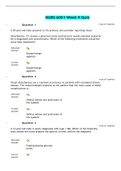
-
NURS 6051 Week 9 Quiz - 100% Correct Questions and Answers
- Exam (elaborations) • 12 pages • 2021
-
- $15.49
- + learn more
NURS 6051 Week 9 Quiz Question 1 A 30-year-old male presents to his primary care provider reporting visual disturbances. CT reveals a pituitary tumor and lab tests reveal elevated prolactin. He is diagnosed with prolactinoma. Which of the following treatments would the nurse help implement? Question 2 Visual disturbances are a common occurrence in patients with untreated Graves disease. The endocrinologist explains to the patient that the main cause of these complications is: Question 3 A 12-ye...
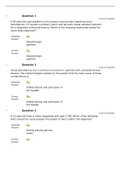
-
NURS 6051 Patho wk9 quiz with Correct Answers
- Exam (elaborations) • 12 pages • 2021
-
- $14.00
- + learn more
NURS 6051 Patho wk9 quiz Question 1 1 out of 1 points A 30-year-old male presents to his primary care provider reporting visual disturbances. CT reveals a pituitary tumor and lab tests reveal elevated prolactin. He is diagnosed with prolactinoma. Which of the following treatments would the nurse help implement? Selected Answer: a. Dopaminergic agonists Correct Answer: a. Dopaminergic agonists Question 2 1 out of 1 points Visual disturbances are a common occurrence in...

-
NURS 6051 Week 1 Quiz - patho | Transforming Nursing and Healthcare through Technology | Walden University
- Exam (elaborations) • 6 pages • 2021
-
- $10.99
- + learn more
1. During childhood, the thymus decreases in size, and this is referred to as _____ atrophy. 2. A patient wants to know the risk factors for Down syndrome. What is the nurse’s best response? 3 . Why is potassium able to diffuse easily in and out of cells? 4. A 13-year-old girl has a karyotype that reveals an absent homologous X chromosome with only a single X chromosome present. What medical diagnosis will the nurse observe on the chart? 5. A 20-year-old pregnant female gives birth to a stillb...

-
NURS 6051 Week 1 Quiz Patho
- Exam (elaborations) • 7 pages • 2021
-
- $11.99
- + learn more
NURS 6051 Week 1 Quiz Patho During childhood, the thymus decreases in size, and this is referred to as _____ atrophy. A patient wants to know the risk factors for Down syndrome. What is the nurse’s best response? Why is potassium able to diffuse easily in and out of cells? A 13-year-old girl has a karyotype that reveals an absent homologous X chromosome with only a single X chromosome present. What medical diagnosis will the nurse observe on the chart? A 20-year-old pregnant female give...
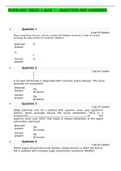
-
NURS 6051 WEEK 4 QUIZ 1 – QUESTION AND ANSWERS
- Exam (elaborations) • 14 pages • 2021
-
- $10.99
- + learn more
NURS 6051 Week 4 Quiz – Question and Answers A 52-year-old female is diagnosed with coronary artery disease. The nurse assesses for myocardial: While planning care for a patient with superior vena cava syndrome (SVCS), which principle should the nurse remember? SVCS is a progressive _____ of the superior vena cava (SVC) that leads to venous distention of the upper extremities and head. Which organ should the nurse monitor closely since it is often the first to fail in patients with multip...
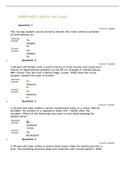
-
NURS 6051 WEEK 3 QUIZ – QUESTION AND ANSWERS (SET 2)
- Exam (elaborations) • 12 pages • 2021
-
- $10.99
- + learn more
NURS 6051 Week 3 Quiz with Answers The nursing student would correctly identify the most common symptom of brain abscess as: A 60-year-old female with a recent history of head trauma and a long-term history of hypertension presents to the ER for changes in mental status. MRI reveals that she had a hemorrhagic stroke. What does the nurse suspect caused this type of stroke? A 20-year-old male suffers a severe closed head injury in a motor vehicle accident. He remains in a vegetative state (VS...
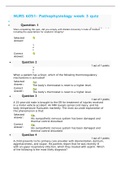
-
NURS 6051 WEEK 3 QUIZ WITH ANSWERS – PATHOPHYSIOLOGY
- Exam (elaborations) • 12 pages • 2021
-
- $11.49
- + learn more
NURS 6051 Week 3 Quiz with Answers – Pathophysiology When a patient has a fever, which of the following thermoregulatory mechanisms is activated? A 15-year-old male is brought to the ER for treatment of injuries received in a motor vehicle accident. An MRI reveals spinal cord injury, and his body temperature fluctuates markedly. The most accurate explanation of this phenomenon is that: A child presents to his primary care provider with disorientation, delirium, aggressiveness, and stupor....
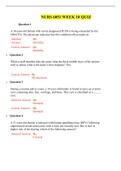
-
NURS 6051 WEEK 10 QUIZ / NURS6051 WEEK 10 QUIZ |Verified and 100% Correct Q & A.
- Exam (elaborations) • 10 pages • 2021
-
- $10.49
- + learn more
NURS 6051 WEEK 10 QUIZ / NURS6051 WEEK 10 QUIZ |Verified and 100% Correct Q & A. Question 1 A 30-year-old female with newly diagnosed PCOS is being counseled by her OB-GYN. The physician indicates that this condition often results in: • Question 2 When a staff member asks the nurse what the thick middle layer of the uterine wall is called, what is the nurse’s best response? The: • Question 3 During a routine pelvic exam, a 34-year-...
![All exams for NURS 6501 Week (All Weeks) [In Bundle]](/docpics/601fa9bd51ca3_978502.jpg)
-
All exams for NURS 6501 Week (All Weeks) [In Bundle]
- Package deal • 8 items • 2021
-
- $24.49
- + learn more
NURS 6051 Week 2 Quiz 2 Exam (elaborations) NURS 6051 Week 4 Quiz 3 Exam (elaborations) NURS 6051 Week 5 Quiz 4 Exam (elaborations) NURS 6051 Week 6 Quiz 5 Exam (elaborations) NURS 6051 Week 7 PATHO QUIZ 6 NURS 6051 Week 8 Quiz 7 NURS 6501 Week 1 Quiz 8 NURS 6501 Week 3 Quiz

-
NURS 6051WEEK 4 QUIZ A+
- Exam (elaborations) • 10 pages • 2021
-
- $11.39
- + learn more
NURS 6051 Week 4 Quiz 1. A 52-year-old female is diagnosed with coronary artery disease. The nurse assesses for myocardial: 2. While planning care for a patient with superior vena cava syndrome (SVCS), which principle should the nurse remember? SVCS is a progressive _____ of the superior vena cava (SVC) that leads to venous distention of the upper extremities and head. 3. Which organ should the nurse monitor closely since it is often the first to fail in patients with multiple organ dys...

Do you wonder why so many students wear nice clothes, have money to spare and enjoy tons of free time? Well, they sell on Stuvia! Imagine your study notes being downloaded a dozen times for $15 each. Every. Single. Day. Discover all about earning on Stuvia


